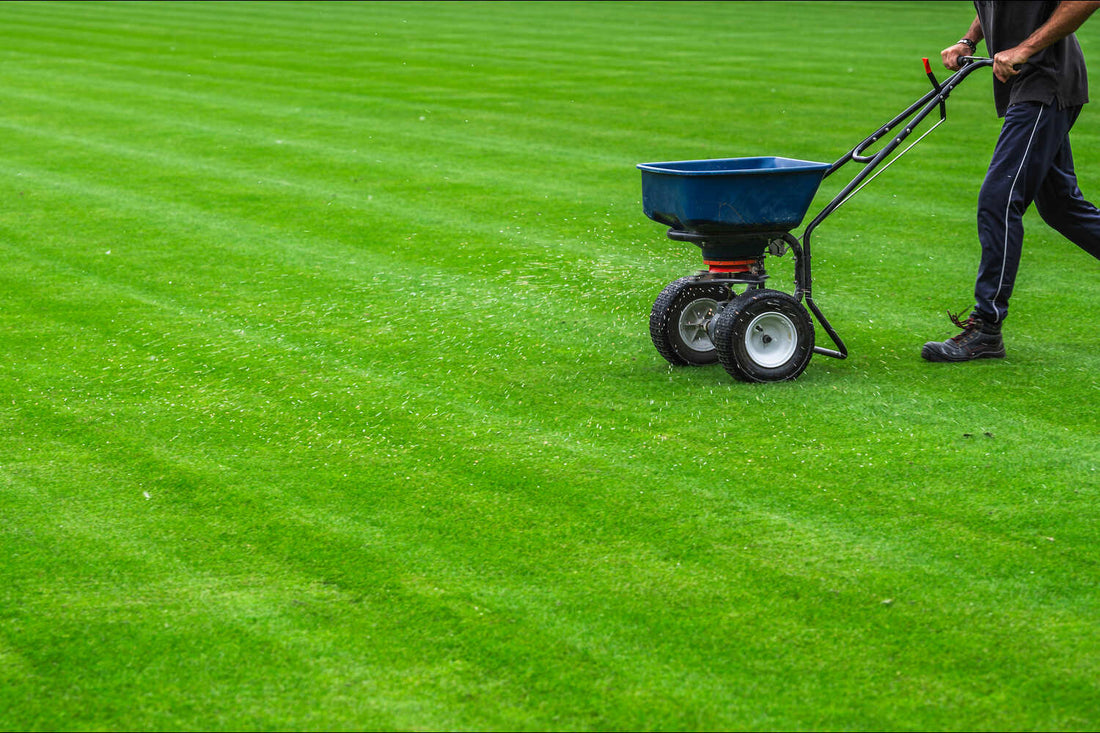Homeowners often ask: is weed and feed a pre emergent? The answer isn't always a simple yes or no. Some weed and feed products can act as pre-emergents—but not all do.
And if you're aiming for a healthy, weed-free lawn, knowing the difference can save you from poor results or wasted time.
At Lawn Synergy, we specialize in helping DIYers achieve professional-grade lawns without the confusion.
Our products aren't just repackaged big-box options—they're enhanced with extra nutrients, designed to work better, and sized for homeowners who want serious results.
In this article, we'll break down what weed and feed actually does, when it functions like a pre-emergent, and when you'll need to use something else entirely.
Let's get into the details that will help you treat your lawn like a pro.
What this article covers:
- What Is Weed and Feed, Exactly?
- Does Weed and Feed Work as a Pre-Emergent?
- How to Identify What Kind of Weed Control Is in Your Product
- When to Apply Weed and Feed for Preventative Results
- Can Weed and Feed Replace a Separate Pre-Emergent?
- Mistakes to Avoid When Using Weed and Feed as a Pre-Emergent
- Tips for Maximizing Effectiveness
What Is Weed and Feed, Exactly?
How It Combines Fertilizer and Herbicide
Weed and feed is a dual-action lawn product. It feeds your grass with nutrients and knocks out weeds using herbicide—all in one application.
That's the appeal. It's easy, convenient, and saves time. But the specific way it controls weeds depends on the formula.
Types of Weed and Feed Products Available
There are two primary types: pre-emergent weed and feed and post-emergent weed and feed. Pre-emergents prevent weeds before they sprout.
Post-emergents kill weeds that have already appeared. Some products may even blend both, but most off-the-shelf options fall into one category or the other. Knowing which kind you're applying is key.
Does Weed and Feed Work as a Pre-Emergent?
Understanding the Role of Pre-Emergent Herbicides
A true pre emergent herbicide stops weeds before they break the soil surface. It creates a barrier in the top layer of the soil, targeting seeds during germination.
When activated properly, it keeps crabgrass, goosegrass, and other annual weeds from ever seeing sunlight. It doesn't kill existing weeds—it prevents new ones from growing.
When Weed and Feed Contains Pre-Emergent Properties
Some weed and feed products contain pre-emergent ingredients like prodiamine or dithiopyr. These are powerful herbicides that can provide solid seasonal control when applied correctly.
If your weed and feed contains one of these, then yes—it functions as a pre-emergent.
But if it's using 2,4-D or dicamba, those are post-emergents, and the product won't prevent new weeds from sprouting.

Comparing Pre- vs. Post-Emergent Weed and Feed Formulas
Pre-emergent versions are typically used early in the season—especially in spring—to prevent annual weeds.
Post-emergents are more common in summer or fall when weeds are already visible. Always check the active ingredients to determine what you're actually applying.
If you're unsure, Lawn Synergy can help you read the label and recommend the right approach.
How to Identify What Kind of Weed Control Is in Your Product
Key Ingredients That Indicate Pre-Emergent Action
Look for active ingredients like prodiamine, dithiopyr, or pendimethalin.
These are common pre-emergent herbicides. If they're listed, your weed and feed is targeting weeds before they grow.
This also means proper timing and watering are essential for effectiveness. And remember—when to water after pre emergent matters just as much as the product itself.
Reading Product Labels for Weed Timing Clues
Labels will often tell you if the product should be used “before weeds emerge” or “on established weeds.”
That's your signal. If it's pre-emergent, it needs to be applied before soil temperatures rise into the weed germination zone. If it's post-emergent, timing is based on visible growth stages.
When to Apply Weed and Feed for Preventative Results
Spring and Fall Timing for Pre-Emergent Control
If your weed and feed acts as a pre-emergent, early spring is prime time. That's when summer annual weeds like crabgrass are getting ready to germinate.
You'll want to apply the product before soil temps hit about 55°F. In some climates, fall applications may be used to target winter annuals.
How Climate and Grass Type Affect Application Windows
Warm-season grasses (like Bermuda or Zoysia) and cool-season grasses (like fescue or bluegrass) have different growth cycles.
Your region also plays a role in timing. Southern states have longer seasons and more flexibility. Northern areas usually have one main window.
Lawn Synergy offers customized support to help you hit the ideal timing for your lawn type and location.

Can Weed and Feed Replace a Separate Pre-Emergent?
Pros and Cons of Using All-in-One Lawn Products
The upside to weed and feed? Convenience. You're tackling two jobs in one application. But the downside is that you lose some control over timing.
Fertilizer and pre-emergent have different ideal application windows. Combining them might mean compromising one or the other. Also, it can be harder to adjust rates independently based on your lawn's needs.
Situations Where a Standalone Pre-Emergent Is Better
If you're serious about weed control, a separate pre-emergent gives you more precision. You can apply it exactly when soil temps hit the sweet spot, then follow up with a fertilizer tailored to your lawn.
This approach allows you to match products more closely to your turf's nutrient profile.
And if you're wondering, can you apply pre emergent and fertilizer at the same time—yes, but it's better when done with purpose-built products, like those from Lawn Synergy.
Mistakes to Avoid When Using Weed and Feed as a Pre-Emergent
Applying at the Wrong Time for Target Weeds
Timing pre-emergent herbicide is all about soil temperature, not the date on the calendar.
Different weeds germinate at specific temperature ranges—crabgrass, for example, begins to sprout when soil hits 55°F consistently for several days.
Applying too early means the herbicide may degrade before weed seeds even begin germinating, leaving the lawn unprotected when it matters most.
Applying too late means the weeds have already emerged, and at that point, a pre-emergent won't do anything. It doesn't kill existing weeds—it only stops new ones from sprouting.
Once emergence begins, you'll need a post-emergent product to gain control. For maximum effectiveness, monitor soil temperature with a thermometer or use online soil temp tracking tools.
Apply pre-emergents just before weeds hit their germination threshold to create a protective barrier right when it's needed.
Overlapping with Seeding or Other Lawn Treatments
Pre-emergents and seeding don't mix. The same barrier that blocks weed seeds also blocks grass seed. If you're planning to seed soon, hold off on any pre-emergent product—including weed and feed.
Want to know how long after pre emergent can I seed? Plan to wait 8–12 weeks, depending on the product used.

Tips for Maximizing Effectiveness
Matching the Product to Your Lawn's Needs
Every lawn is different. That's why Lawn Synergy offers soil testing, analysis, and customized recommendations. W
e'll help you choose the right weed and feed—or separate herbicide and fertilizer—to match your grass type, current weed pressure, and growth cycle. No guesswork, just expert-backed results.
Watering and Mowing Guidelines After Application
Watering activates pre-emergents. Most weed and feed products need about ¼ inch of water within 24 hours to form the soil barrier.
If your product isn't watered in, it won't work. And mowing too soon can disturb the barrier before it settles. Check the label or contact our team for guidance.
Conclusion
So—is weed and feed a pre emergent? Sometimes. It all comes down to what's in the bag.
If the product contains a true pre-emergent herbicide like prodiamine or dithiopyr, then yes—it can prevent weeds before they sprout.
But many weed and feed products are post-emergent, designed to knock out existing weeds, not stop new ones.
The best approach depends on your goals, your lawn's condition, and your timing. At Lawn Synergy, we help you choose smarter—not just easier.
Our enhanced, professional-grade products are designed for homeowners who want results, not guesswork.
With expert support, premium ingredients, and a customized subscription program, you'll finally have the lawn you've been aiming for. Let's make it happen—together.
If you want to learn more, check out this article below:
- Will Pre Emergent Kill Grass Seed
- What Is a Pre Emergent?
- How Do Pre Emergent Herbicides Work?
- Pre Emergent Herbicide List
- Pre Emergent vs Post Emergent
- What Is Pre Emergent for Lawns?
- When to Apply Pre Emergent
- When to Apply Pre Emergent in Texas
- When to Apply Pre Emergent in Fall
- When to Put Down Pre Emergent in Spring
- When to Apply Crabgrass Pre Emergent
- How Long Does Pre Emergent Last?
- Is It Too Late for Pre Emergent?
- Does Pre Emergent Work?
- Can I Put Pre Emergent on Wet Grass?

